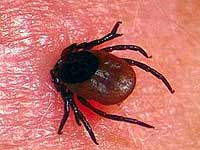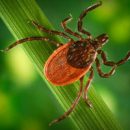What to do if the tick was bitten? How to remove it from the skin? Do I need to do any tests? All these questions are important, especially if you survive in the regions endemic by transmissive infections carrying by ticks.
Content
Tick bite is dangerous with the possibility of infection with transmissible infections. These bloodsowing arthropods are carriers of causative agents of tick-borne encephalitis, Lyme disease, ticky spotted fevers, Crimean and Omsk hemorrhagic fevers and other diseases. In fact, the whole territory of Russia is the area of habitat of ticks and annually about bites in hospitals and trauma items turns to ten hundred people.
If you were bitten by a tick?
 What should I do if bitten by a tick? First of all, do not panic. Of course, the sooner you remove the tick, the better, but the bill is not for a minute, so it's not worth a hurry in this situation. All the necessary information about what you should do, you can get by calling 03.
What should I do if bitten by a tick? First of all, do not panic. Of course, the sooner you remove the tick, the better, but the bill is not for a minute, so it's not worth a hurry in this situation. All the necessary information about what you should do, you can get by calling 03.
If the tick was bitten, then the best way out of the situation will be the appeal for professional medical care in the trauma art, but there is no such possibility, and therefore it will have to remove the tick on their own.
What do not do!
- Make petroleum or oil rods, tick from this will not leave his place, and if she leaves, then no soon. At the same time, the risk of infection will increase directly transferred ticks in the skin.
- Apply to the place of fastening the tick tampon with caustic liquids, for example, gasoline, ammonia, catching ticks with fire — This, of course, destroy the parasite, but its parts remaining in the skin will cause inflammation, and the risk of infection will not decrease.
- Sharply pull the ticks, squeeze it with the abdomen with his fingers or tweezers, as it is fraught with a cliff of his head.
What to do!
If it is impossible to seek medical help, you need to remove the tick yourself. The earlier you remove the parasite, the less risk of infection with infection. All actions should be thought out, performed slowly and clearly.
Methods of self-removal of tick
- Surgical tweezers, clamp, tweezers for epilation or other tool to capture the parasite head as close as possible to the trunk. After fixing the tweezers, start gently and slowly squeeze and at the same time rotate in a comfortable side of the tick head. Usually after 2-3 turns of the tick is removed entirely together with the head and trunk.
- Removing tick thread. Take a solid thread, wrap around a tick head as close as possible to the skin and a trunk, tighten the loop and then, slowly swaying from the side to the side and pulling up, remove the parasite outward. Sharp movements are unacceptable because the tick can break and have to get it in parts.
- Removing a tick using special devices. They are quite a lot and proven them well. The advantage of a special tool is that it does not squeeze the tick abdomen, prevents its contents from entering the wound, and therefore reduces the risk of infection with transmissible infections.
After removal of the tick, the bite place is treated with iodine, a solution of diamond greenery or any antiseptic. Imposition of dressings is not required.
What to do if the tick head remains in the skin?
Sometimes with an inept extraction of a tick of his abdomen, the head or proboscis remains in the skin. In this case, infection can continue, since the pathogenic microorganisms are contained in the salivary glands of the parasite, which means that the head must be removed. Of course, it is better to seek medical care, but if there is no such possibility, you will have to act yourself, as in the case of the usual.
The place of bite is treated with an antiseptic, such as alcohol, and neatly, trying to injure fabrics as little as possible, get the head with a sterile needle. The needle can be splitting on fire and coercive, use it as a surgical instrument. In any case, the processing of the wound after the tick bite requires caution.
Where to carry a tick? Do you need analyzes?
First of all, it is worth clarifying whether the area of your stay is endemic to various transmissible diseases. If not, then research is usually not carried out, as well as preventive vaccinations.
In the endemic zone, even in the event of a quick extraction of the tick, to exclude the infection with tick-borne encephalitis and other infections can not. The study of the tick for infection can be carried out in special laboratories.
How to store and transport ticks? It should be placed in a glass vessel along with a small wet piece of cotton wool moistened with ordinary water, close tightly with a lid and put in the refrigerator until the moment of transportation to the laboratory. It should be borne in mind that many laboratories do not take on the study of dead ticks. Therefore, if the ticks failed to get completely, it is necessary before carrying it on the analysis, clarify in the laboratory - will they take it in this form.
Do I need to be examined after bite?
It should be remembered that the bite of the tick is not a sentence, the infection occurs not in 100% of cases. In case the tick turned out to be encephalitis, the tests are recommended to be submitted, if not, to pass the survey is better for your own peace. It should always be remembered that the consequences after the bite of the encephalute tick is very serious.
The examination for the presence of tick-borne encephalitis and borreliosis involves the blood test by the PCR method, but not earlier than 10 days after the tick bite. Antibodies to the tick-borne encephalitis virus can be found after 2 weeks, and antibodies to borreliam only in a month.









